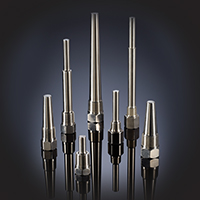THERMOWELLS

Thermowells are principally used with Thermocouples, RTDs (Resistance Temperature Detectors) and Bimetal Thermometers in applications where it is necessary to measure temperature at high pressure (above 75 psig) or in hostile environments. They are also used for isolation, so a sensor can be replaced without having to shut down the process. Thermowells are machined from solid barstock. Safe working pressures depend on the well material, operating temperature and the velocity of the flowing medium.
Thermo-Kinetics stocks a complete range of standard tapered, straight and reduced-tip thermowells to meet most applications. Flanged, Socket Weld, Van Stone, Ground Joint and Weld-in thermowells are also available. Special wells in various materials, sheaths and coatings meet unique requirements.
Thermowell Velocity Calculations
When fluid flows past a thermowell, low pressure vortices are formed in the wake downstream of the well. These vortices shed from alternate sides of the well and the resulting differential pressure produces two periodic forces on the thermowell:
- an oscillating-lift force, transverse to the fluid flow at frequency fs
- an oscillating-drag force, in-line with the fluid flow at frequency 2fs
Vortex shedding can occur at frequencies from 50Hz to 1500Hz. The vortex shedding frequency (Strouhal Frequency) increases linearly with fluid velocity, but the forces increase with the square of the velocity. When the Strouhal Frequency approaches the natural frequency of the thermowell, it can lock-in to the natural frequency causing resonance, with greatly magnified forces. To prevent lock-in, the natural frequency of the thermowell must be higher than either the in-line or the transverse resonance condition. Operation through the in-line resonance is acceptable only if the cyclic stresses at the resonance condition are acceptably small.
The fluid velocity at which resonance occurs is referred to as a velocity critical. There are two velocity criticals for each natural frequency of the thermowell: one describing the transverse and the other describing the in-line response. Since in-line force fluctuates at twice the frequency of the transverse force, the corresponding velocity critical is approximately one half that requires for transverse resonance. If the natural frequency of the thermowell overlaps either fs or 2fs, a large resonant buildup in vibration amplitude can occur. The major cause of thermowell failure is fatigue due to resonance. A high enough level of damping may allow the thermowell to operate at the in-line or even the transverse resonance frequencies.